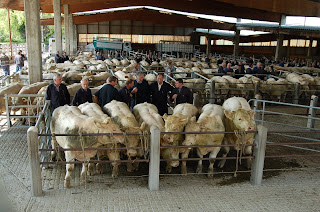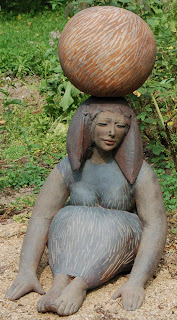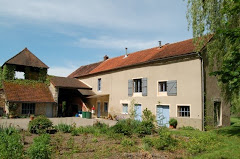Last week we had encounters with a few people who once, not so long ago, were seen as sworn enemies of the “free” Western world.
The first encounter was during a rather bizarre bicycle accident. We decided to travel by car to Bonnay, in order to visit a guy who makes beautiful wooden miniatures. In stead of taking the main road, we decided to drive along a narrow country road. We had just crossed the Voie Verte at Cormatin, when we saw a female cyclist coming towards us, cycling in the middle of the road. The moment she saw us, something very strange happened. We had already stopped, when we saw her body moving forward over the handle bars, while at the same time the back wheel moved up in the air, and the bicycle landed on top of the woman. Once we got out of the car, it seemed that the woman was laying in a pool of blood. Fortunately things looked graver than they were.

We helped her up, untangled the bicycle and found out that she was a young Russian woman, staying in Taizé. She was sent out by a friend on the (borrowed) bike to get some shopping from Cormatin. Then it became more or less clear what had happened. The woman was carrying a very heavy rucksack, not on her back but in a little basket hanging in front of the handle bars. The basket further contained some bags of fruit and a bottle of wine.
Another bottle of wine she held in her hand whilst cycling. Obviously she was not a very experienced cyclist. When she saw us coming towards her, she panicked, and braked with her free hand. The free hand operated the front brake. This combined with the centre of gravity of her luggage and shopping, made the bicycle topple over, and she went with it. The blood she was bathing in appeared to be the content of two bottles of wine. Once we got her up and standing, she seemed alright, although very shaken. We decided to take her to Cormatin by car, to see at least a pharmacist, and if necessary a doctor. So Sue drove off with our new Russian friend, and I followed them on her bike. At the pharmacy they checked and cleaned her wounds (mainly grazes, also under her cloths) and, although the pharmacist actually wanted her to see a doctor, the woman insisted on leaving for Taizé. So we put the bicycle, luggage and shopping in the boot of the car, and brought her back to Taizé. Some people might think something higher was involved in this accident: the intake of alcohol is frowned upon in Taizé, and those staying their get only very few vouchers which they can spend on alcohol in the Taizé-run café……

Our second encounter with Russians took place the same week. The choir “Les Voix de la Nèva” from Saint Petersburg was performing in the Saint-Philibert abbey church of Tournus.
Those concerts are usually of high standard and hence very popular, reason why we had bought tickets well in advance. The choir was indeed excellent. The five men and five women performed a beautiful concert. Their voices sounded beautiful, not in the least because the acoustics of the abbey church is superb. Before the break they sang a program of Russian-Orthodox church music, and after the break they sang a collection of profane songs. One of the high lights of the last bit of the program was a stunning performance of “Vecherniy zvon”. The English title is “Evening bells”, and interestingly enough, the lyrics are a translation of Thomas Moore’s poem “Those evening bells” (Irish melodies, 1808).
For those who want to hear the melody click here. This week had a very high nostalgia content. Not only brought it back sweet memories of a very popular Russian language TV course which I once followed (only sweet memories came back, and hardly any Russian words!), but the song brought back memories of a very popular radio program from my youth. Each broadcast was dedicated to a specific firm, company or factory, of which the employees could request certain tunes to be played. And one of the very popular tunes was : indeed, “Vecherniy zvon”, performed by a very popular Dutch choir!
The website of La Tuilerie de Chazelle






































